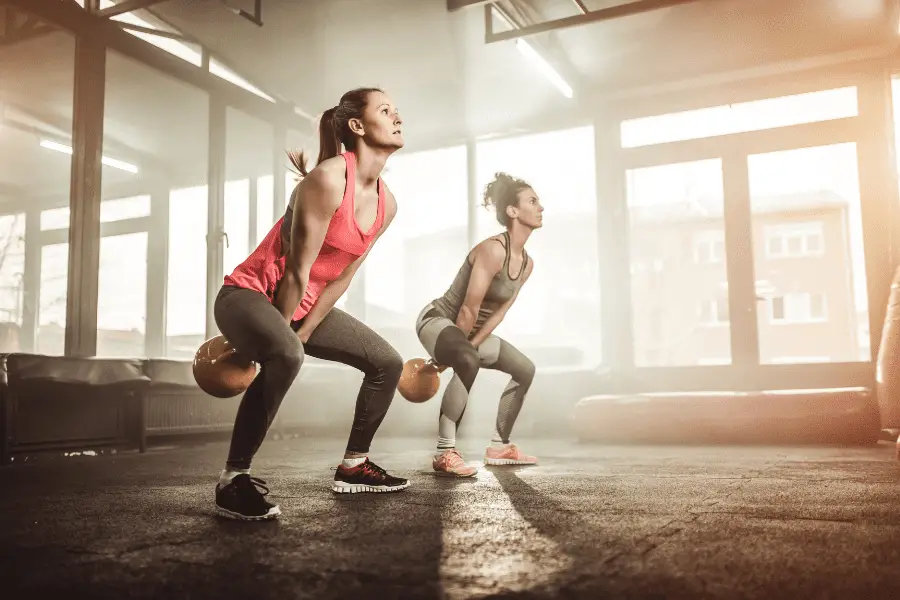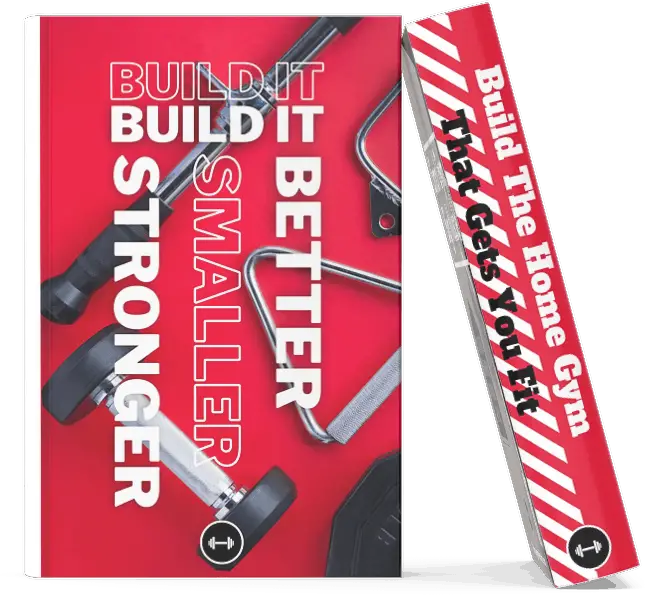The deadlift is an awesome strength and muscle builder. Not all home gyms are big enough to comfortably do deadlifts however, how can you still lift when you’ve got a small space?
Here are the 6 best tips that allow you to deadlift in a very small space:
- Use a shorter barbell
- Diagonal
- Perfect your form
- Open the door
- Don’t drop the bar
- Do alternative exercises
If you implement one or more of those tips, you might be able to deadlift where you couldn’t before.
Maybe those tips don’t seem very obvious and you’re wondering what they actually mean. Keep reading to find out exactly how and what.
Check out my eBook! It shows you exactly how to build a complete home gym in a small space.
Contents
1. Use a shorter barbell
The width of the barbell is the biggest problem in most cases. If you can’t physically fit the barbell between two walls, it’s going to be very difficult to actually perform a proper deadlift.
Making your home gym bigger or even just wider is probably out of the question. The next best option is to get a shorter barbell. A standard barbell is 7’2 or 220 cm long. That’s pretty long and while that’s the official size you’ll find everywhere from competitions to your local gym, it doesn’t mean you actually have to use that one in your home gym.
There are plenty of barbells available that measure about 6’ in length. That could mean the difference between being able to deadlift comfortably and not at all.
Can you use short barbells in your home gym? Click here to find out everything you want to know.
Are there any drawbacks to using a 6’ barbell? The shaft and the sleeves are both a bit shorter. This means there is a little less space to grip the bar and a little less length to put plates on the bar. The average 6’ bar can still hold 360 lbs. if you load them up with 45 lbs. bumper plates so that should be plenty for the majority of people. If you use thinner plates you can fit much more than that.
Another drawback is that the ‘whip’ will feel a bit different. Since the bar is shorter, it might bend a bit less when lifting and this will feel a bit different in your hands. Does this really matter? Not for most recreational lifters. If you’re training for a competition it could make a small difference if the bar on the stage suddenly feels a bit different.
Learn everything about barbells here. (click)
2. Think about Pythagoras
Most rooms are square or rectangular. To deadlift, you need to be able to put the bar flat on the floor without any interference. If the long side of your room is still too short for a barbell, there is another angle you can take.
If you go back to middle school math class you might remember Pythagoras’ theorem. Without going into the math, crossing a square or rectangle diagonally is longer than going along one of the walls.
It could mean the difference between fitting in the barbell or not.
One thing you might have to watch out for is if the weight plates fit in the corners of your room. Going straight along a wall, the weight plates are not in a corner so they’ll always fit as long as you’ve to the length. When you’re using big plates and you’re close to a corner, the weight plates could hit the walls.
Just check before you punch a hole in four walls at the same time on your first deadlift.

3. Perfect your form
If your form is perfect, the bar travels straight up and down. That means you need less space in front of and behind the bar. The space you need to take off weight or load the bar should then be enough to perform the lift.
If you’re not sure about your form at the moment, you can do a few things;
- Video yourself or ask someone else to video you during a deadlift. Take the video straight from the side so you can clearly see the bar path.
- Ask a good trainer to correct your form. An experienced trainer can see things you won’t notice yourself even if you’ve got the video.
If your bar goes straight up and down, you need less space since there is no need for room for mistakes. Although mistakes can still happen of course.
4. Open the door
Possibly your gym has a door somewhere. Possibly opening that door could give you enough space to fit the barbell.
Open the door and stick the bar through as far as you need to make it fit. Make sure your body isn’t in the doorway because that won’t provide you enough space to bend over. A doorway should be plenty wide to accommodate lifting
Since you’ve perfected your form in the last step you don’t actually need a very wide doorway to accommodate a deadlift. The bar should go pretty much straight up and down so as long as it fits on the floor, it’ll fit when you lift it as well. It’s not even necessary to have a very wide doorway. Just a bit wider than the weight plates should be fine.
If you have to put your barbell partly outside, there is a possibility you don’t have proper gym flooring in the place where the ‘outside’ weights land. This can damage your floor. Having a bit of extra gym mat or a pad around you can put in the doorway when deadlifting with the doorway open, can help you protect your floor, equipment, and hearing. Dropping weights on a hard floor can be noisy!
5. Don’t drop the bar
I know, sacrilege. Just lower the bar in a controlled manner. There are a few benefits to this;
The bar has less velocity when it hits the floor. This creates less noise, less damage and there is a lower chance it’ll move somewhere you don’t want.
If you drop the bar, you lose all control. There is nothing you can do to change the path or what happens after it hits the floor. It can roll into a wall, or something that’s easily damaged.
Another benefit is that you get some extra eccentric overload. This could give you some extra hypertrophy although it also makes recovery a bit more difficult.
If you live in an apartment or are lifting on a second or higher floor, your downstairs neighbors will be thankful as well.
6. Alternative exercises
If all of that still won’t give you enough room to do a proper deadlift, it’s time to look at some alternative exercises. There are a few exercises that are great alternatives;
- Dumbbell deadlifts.
- Cable pull through
- Kettlebell swings
- Isolate the different muscles used in the deadlift.
The main difference with the barbell deadlift is that you can load a barbell much heavier than the other exercises. Good luck finding 200 lbs. dumbbells. If lifting heavy is your priority, there is no substitute for a barbell deadlift.
The heaviest alternative is the dumbbell deadlift, how heavy you can go depends on how heavy your heaviest dumbbell is. Kettlebell swings are an awesome exercise to practice your hip hinge and posterior chain. It’s better to do them for higher repetitions though.

How much space do you need to deadlift?
How much space do you actually need to deadlift in a home gym? Let’s think about it.
You need space to:
- Put the barbell and the weights flat on the floor
- Load and unload the weight plates from the bar
- Space to bend over and grab the bar
How much space is this?
- The barbell is 7’2 or 6’ long
- You need at the very least 5” on both sides of the bar to load and unload the weight plates. 10” is better. This also helps you not to scrape the walls when lifting.
- The space you need to bend over. The minimum space you need for that is the length from your tailbone to the top of your head. I’m 6’1 and that measurement is about 41” for me but everyone is different. I wouldn’t recommend just having that amount of space available for deadlifts though. Putting your ass against one wall and the top of your head against the other on every rep isn’t great. I’d add at least 1’ to that measurement and 2 is probably better. You’ll still have to be careful and not move around too much.
That said, your torso length will hardly ever be the problem. The length of the room you need for the length of the barbell and weights.
Total necessary space for deadlifting
For a 7’2 barbell
- 7’2 + 20” = 106”/269cm long.
- 41” + 2’ = 65”/165cm wide.
For a 6’ barbell
- 6’ + 20” = 92”/241cm long.
- 41” + 2’ = 65”/165 cm wide.
That will be enough space to comfortably deadlift. It’s not enough space to do anything else, however. If you’re wondering how much space you need for a full home gym, check out this post. (click)
Don’t forget to check out my eBook!
Related questions
How heavy is a barbell? A certified 7’2 Olympic barbell weighs 20 kg/45lbs. 6’ barbells often weigh 15 kg/33 lbs. Non-certified barbells are not guaranteed to be a certain weight. While the vast majority of barbells weigh 44 lbs., there are plenty of (cheaper) barbells that have different weights.
Looking for a good barbell and weights that will last for decades? Click here to find my recommendation.
Favorite Barbell Accessories
Your barbell workouts will be made better by these accessories:
- Barbell collars: Keep the plates securely in place with these barbell collars (Amazon link)
- Micro plates: This set of micro plates (Amazon link) allows you to add small amounts of weight to the bar so you can keep making progress.
- Squat pad: Need a little padding between your back and the barbell? This Profitness squat pad (Amazon) is both high quality and affordable.
- Deadlift pads: Dramatically reduce the noise and impact on the floor when deadlifting with these Yes4All pads (Amazon).
Find my favorite barbell and weight plates by clicking here.



